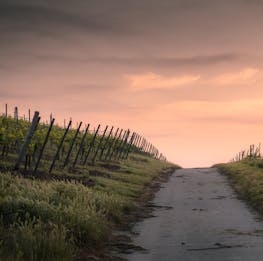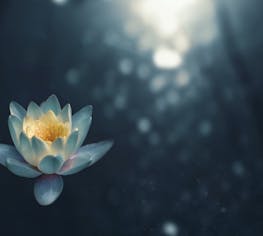Big Magic Summary
How to Live a Creative Life, and Let Go of Your Fear
Do you want to unleash your inner creativity, but are afraid that you're just not "the creative type"?
Big Magic is written as a template, with lessons on how to unleash our creativity. The chapter headings are bold words: Courage, Enchantment, Permission, Persistence, Trust, and Divinity. Each chapter contains inspirational stories to guide us towards the magic that is creativity, curiosity, love, wonder, and bravery.
Author Elizabeth Gilbert believes that to call someone a "creative person," is laughably redundant. She believes that creativity is the hallmark of our species; we have a sense for it and a curiosity for it. In short, the divine nature of creativity resides within all of us. However, it's easy to forget this. Fear creeps in, and we stray from our creative selves, and when this happens, we miss out on something magical, the chance to feel truly alive, in flow, and enchanted by life.
Let's briefly explore the magical realm of creativity, how ideas have an agency of their own, and how to engage in the creative process from a place of curiosity, playfulness, and love.
Are you Ready to Unleash your Inner Ice Skater?
Before we explore the magic of creativity and how to tune out the voice of fear, let's remember what the essence of creativity is.
Gilbert illustrates what creativity-in-action looks like, by beginning the first chapter with a story about her friend Susan. Susan woke up on her fortieth birthday, with a feeling of restlessness. She hankered for a lighter, more joyous, and "creative" sense, and she realized the last time she'd felt such feelings was decades ago when she was a figure skater. So, she followed her curiosity to see if she would still love skating as much as she had then. She hired a coach, bought a pair of skates, and went three mornings a week before dawn to skate. She didn't quit her job, sell her home, or train tirelessly to reach Olympic-level skating standards, and this story doesn't end with her winning any championship medals. The point is that the story doesn't have to end in this manner. In fact, the story doesn't end at all because Susan is still figure skating. For Susan, skating remains the best way for her to find beauty and transcendence in her life.
The message here is that anything is creative as long as it makes us appreciate the value of life, joy, and childlike wonder. To tap into this awe-like wonder, we need to re-connect to the magic of creativity.
What if Creativity Is a Force of Enchantment?
What if creativity isn't entirely human in its origins? Gilbert spends her life devoted to creativity, and along the way, she's developed a set of beliefs about how it works, and how to work with it. She believes, unapologetically, that the creative process is a magical one.
Our planet isn't just inhabited by animals, plants, bacteria, or viruses, it's also inhabited by ideas. Gilbert invites us to think of ideas as living separate life forms, that have one impulse: to be made manifest. It's only through our efforts, that ideas can be escorted out of the ether, and into the realm of the actual. Ideas seek us, inspire us, and ask us to bring them to life.
When ideas come knocking, they will send us the universal physical and emotional signals of inspiration: the chills up our arms, the hair standing up on the back of our neck, and the butterfly stomach. The idea will organize coincidences for us to stumble upon to keep us interested. Ideas keep us up at night, distract us from the daily routine, and won't leave us until it has our full attention. Then in a quiet moment, an idea will ask whether or not we want to work with it. Should we freely choose not to, the idea will move on.
To convince us that ideas have agency, Gilbert tells the story of an idea that jumped from her, to her writing friend, Ann Patchett. Inspired by her husband's Brazilian roots, Gilbert had an idea for a novel set in the Amazon jungle. Despite being inspired and energized by the idea, she didn't commit to the story and continued with other projects. She left the idea unattended for too long, and over time she lost the inspiration to bring the concept to life. It was around this time that Gilbert made friends with writer Ann Patchett. Coincidently, Patchett had begun to write a book set in the Amazon. The storyline was eerily similar to Gilbert's conceptualization. Both writers were amazed and, to this day, firmly believe that the idea migrated from Gilbert to Patchett, who was open to giving it life.
The message here is that we need to permit ourselves to create, despite our fears.
Creativity Is a Path for the Courageous, Not the Fearless
Is there something creative you'd like to do, but feel too afraid?
Perhaps we fear what people will think of our creative efforts. Or we tell ourselves that if our creative pursuits are not meaningful, impactful, or exceptional by conventional standards, then why create at all? Or we believe that creativity is a rare gift that only a select "artistic" few are born with. All too often, the voice of fear drowns out creativity's call to be expressed.
To simply let go of our fears is easier said than done. In fact, it's impossible. If our goal is to live a fearless life, then we need to think twice. We need fear for obvious reasons of basic survival. Evolution did well to install a fear reflex within us. Without it, Gilbert says that we'd 'lead one short crazy stupid life.' So we need our fear to stay alive. But the trouble is that fear can also prevent us from feeling alive. When fear takes the driving seat in the realm of creative expression, we run into trouble.
In a creative life, our passions coexist with our fears. If we want to do exciting things, make interesting things, and bring our creative treasures to light, we need to learn to travel comfortably alongside our fears. How do we do this? Before taking a "creative road trip," maybe have a conversation with fear, as Gilbert does. She starts by saying, 'Dearest Fear: Creativity and I are about to go on a road trip together. I understand you'll be joining us, because you always do... But understand this: Creativity and I, are the only ones who will be making any decisions along the way...'
So fear can be our backseat passenger, keep us company, and remind us what we deeply care about, but nothing more. However, fear is not permitted to grab the wheel and take us down detours of self-doubt.
Let's explore four ways, that Gilbert suggests to keep fear in check.
Give Yourself Permission to No Longer Need Permission
When it comes to your creative pursuit, have you ever paused to think, who am I to do this?
We often seek permission to express ourselves creatively, rather than feel as if we have the agency to tackle creative projects. Perhaps we fear that we may not be original enough. We worry that ideas are just commonplace and therefore unworthy of creation. An aspiring writer once told Gilbert that she had an idea for a book, but was afraid that it had already been done. To which Gilbert replied: 'Yes, it has already probably been done. Most things have already been done, but they have not been done by you'. Gilbert's advice is to be less driven by originality, and driven more by authenticity.
Our creative pursuits also don't have to be deemed important by others, nor do we have to save the world with our creativity. Although it's very kind to want to help people, it doesn't have to be our sole creative motive. Gilbert once wrote a book to save herself. She wrote it to make sense of her journey through emotional confusion. Her primary motive was to write to figure herself out. In the process, she wrote a story that was a support for many people. The book is called Eat Pray Love. Despite its unintended success, she didn't write it to help others, but rather because she found it an enjoyable and useful topic to contemplate and write about. Ironically, by inadvertently pursuing what we love, this sometimes ends up helping others. Theologian Paul Tillich says, 'there's no love which does not become help.'
Lastly, we need to believe we're entitled to create. You might shudder at the word, but we must possess some level of entitlement to be free to explore. The poet David Whyte calls this kind of entitlement, "the arrogance of belonging." Make no mistake, an arrogance of belonging isn't about egotism or self-absorption. In a strange way, it's the opposite. It's a divine force that will take us out of ourselves and allow us to engage more fully with life.
So forgo the need to get a permission slip. The idea is to do whatever brings you to life, and in doing so you'll bring a sense of lightness to the creative process.
Unleash Your Inner Trickster
Have you ever heard the saying that, 'you're the company you keep?'
At some point in the creative process, we'll have to pick which company we want to keep. Which parts of yourself do you want to nourish, cultivate, and bring into your being? Do you want to be the martyr or the trickster? And, what's the difference between the two? The martyr has a dark, solemn and rigid energy. On the other hand, the trickster has an energy that's light, sly, and endlessly shape-shifting. A martyr believes that life is pain, while the trickster believes that life is interesting. Furthermore, a martyr believes that all truth shall be revealed through torment, whereas a trickster says: 'I didn't come here to suffer.'
Gilbert believes creativity is born out of trickster energy. One such trickster is author Brené Brown. Brown comes from an academic background deeply entrenched in "martyrdom." Academia is a place where people labor and suffer for years, to produce work that only a handful of people will ever read. When Brown looked at her work habits, she realized that she'd been writing from a dark, heavy place within herself. She realized that while writing was generally tricky for her, storytelling wasn't. Brown is a captivating storyteller and loves public speaking, so she figured out how to trick the process. While beginning work on one of her books, she wanted to try something new. She enlisted two trusted colleagues to sit and listen, and she took detailed notes while telling them stories about her book's subject. After each story, she'd grab the notes, run to the other room, shut the door, and write down exactly what she had just told them. She could capture the notes and transcribe her stories, and her writing was faster and better. She figured out how to trick the system and had a good time doing it. According to Gilbert, that's how a trickster gets stuff done.
However, engaging with our creative side isn't all fun and games, we need to remain devoted to our creative pursuit. So keep the spark alive, and make creativity your muse.
Have a Creative Love Affair
Although Gilbert is an advocate for magical thinking, she's not naive. Wishing for success, hours of dedication, and having all the right contacts doesn't guarantee success. Creative living is stranger than other more worldly pursuits. Usually, in life, if we're good at something and work hard enough, we're likely to reap the rewards of success. But with creative endeavors, we may or may not succeed. There are no guarantees.
So, why do some people still manage to persist in the creative process, even when it's difficult, inconvenient, and often financially unrewarding? The answer is that it all comes down to that four-letter word. Love.
Before authors J.K. Rowling and Toni Morrison became the literary legends we see them as today, they vowed to continue their love affair with their writing, despite having other full-time work obligations. They stole hours from each day to write. They did not feel obliged or expect external rewards. It was time with their love. For these authors, writing was like indulging in a passionate love affair.
So, perhaps it's time to stop treating creativity like a tired old marriage, and start seeing it with fresh eyes, like a passionate lover. Even if it's only fifteen minutes a day to be alone with creativity, you should always take it. Don't think of it as burdensome; think of it as a passionate escape. And maybe the next time you stare down at a blank page with frustration, get out of your chair and freshen up. Take a shower, pick a great outfit, get dressed, spray on some perfume or cologne, and show up for your creative muse. Seduce your creativity back into action. This is what Gilbert does, so why not give it a go?
Trust That Creativity Loves you Back
Gilbert's friend, Dr. Robin Wall Kimmerer is a botanist who teaches environmental science and forestry. Before she helps her students get down to the business of world-saving, she asks two questions. The first question is: 'Do you love nature?' Every hand goes up. The second question is, 'Do you believe that nature loves you in return?' Every hand in the room goes down. Robin believes that, in modern times, we have lost our sense of this conversation. We have lost the awareness of communicating and listening to the earth. Without this sense of relationship, we're missing out on something fundamental: we're missing out on our potential to become co-creators of life. As Robin says, 'the exchange of love between Earth and people, calls forth the creative gifts of both.' The earth isn't indifferent to us but rather calling for our gifts, in return for hers. This is the reciprocal nature of life and creativity. Before Robin's students can heal the world, they first need to heal their notion of themselves within the world.
We tend to think that the creative process is one of suffering. Oscar Wilde once called the creative process, 'one long lovely suicide.' Despite her admiration for Wilde's creativity, Gilbert has trouble seeing the loveliness in such anguish. What if the creative process doesn't have to be a war zone filled with despair and darkness? And, perhaps creative pursuits don't wish suffering upon us. Why wouldn't creativity love us, because ideas seek us out? And why would something that deliberately seeks us out, try to harm us, especially because we're the catalyst that brings them to life? All ideas ask of us, is for our attention and devotion.
In Conclusion
Gilbert invites us to see creativity in a magical light, and she offers a sense of lightness to the creative process. We can support ourselves and others in creative efforts, and acknowledge that there's sufficient space for everyone. We can measure our worth by our dedication to the creative process, as opposed to conventional success. And we can replace our creative martyrdom mindset with a more magical one. What if we're neither a slave nor master to our creative inspirations, but rather in partnership with them?
Gilbert herself is the first to admit that this may sound a little delusional, but defends this by saying, 'If you are going to live a life based on delusions (what we all do to some extent) then why not at least select a delusion that's helpful?' She suggests that the work wants to be made, and it wants to be made through you. So the aim is to develop courage and a fierce trust in our creativity, and to find the belief that we're all worthy of creating and sharing, regardless of the outcome.
So now that you know creativity is your birthright, can you access the courage to bring life to the creative treasures that reside within?




